Finding the right mortgage is crucial if you can’t pay for a home in cash. It’s a big decision since you’ll be paying back the loan for many years. You need to pick one that fits your budget and needs.
A mortgage payment has two main parts: the loan amount, called principal, and the interest on that amount. The U.S. government backs some mortgage loans but doesn’t lend the money itself.
Key Takeaways
- Understand the different types of mortgage loans, including conventional, conforming, non-conforming, FHA, VA, and USDA loans.
- Determine whether a fixed-rate or adjustable-rate mortgage is better for your needs and budget.
- Explore first-time homebuyer programs that can help make homeownership more accessible.
- Calculate your budget using the 28/36 rule to ensure you can afford the monthly mortgage payments.
- Compare multiple mortgage lenders to find the best interest rates and loan terms.
Understanding Mortgages
A mortgage is a loan to buy a home. You agree to pay back your loan with interest over a certain term. Your mortgage payment has two parts: principal and interest. Principal is the loan amount, and interest is extra money charged by lenders for borrowing.
What Is a Mortgage?
When looking at loans, check the annual percentage rate (APR). It shows the total cost of a loan, including interest rate and fees. You’ll pay the lender monthly installments based on the loan’s amortization schedule during the term.
“A mortgage is a loan taken out to purchase a home. As a borrower, you’re entering a legal contract to repay your loan, with interest, over a set amount of time.”
Knowing the basics of a mortgage is key when looking at home loans. Learn about principal, interest, APR, and amortization schedule. This helps you choose the best loan for you.
Types of Mortgages
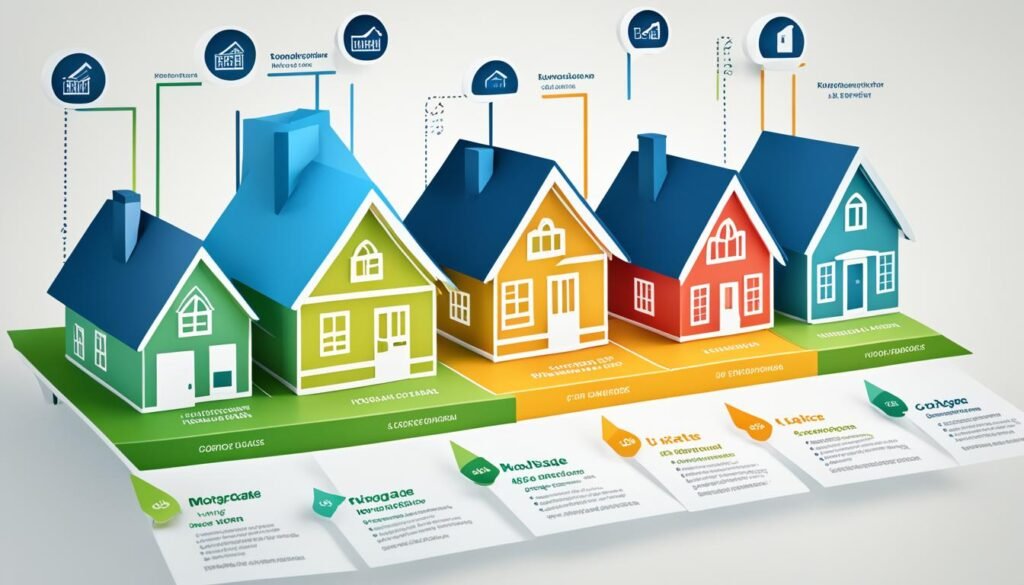
When looking for a mortgage, you have several options. The main types are conventional, conforming, and non-conforming loans. Knowing the differences can help you pick the right one for buying a home.
Conventional Mortgages
A conventional mortgage is not insured by the government. You need good credit, stable work, and a 20% down payment to get one. This way, you avoid paying private mortgage insurance (PMI), which covers the lender if you default.
Conforming Mortgage Loans
Conforming loans are conventional mortgages that follow certain rules set by Fannie Mae and Freddie Mac. These rules include a loan limit, which is $726,200 for a single-family home in 2023. Getting a conforming loan is often easier and may have better interest rates than non-conforming loans.
Non-Conforming Mortgage Loans
Non-conforming loans are for amounts over the limits set by Fannie Mae and Freddie Mac or don’t meet their criteria. Jumbo loans are a type of non-conforming loan for amounts over the limit. They require a high credit score, a big down payment, and more paperwork from you.
| Loan Type | Loan Limit | Down Payment | Credit Score |
|---|---|---|---|
| Conventional | Varies | 20% or more | Good to Excellent |
| Conforming | $726,200 (2023) | 20% or more | Good to Excellent |
| Non-Conforming (Jumbo) | Exceeds $726,200 | 20% or more | Excellent |
Knowing the differences between conventional, conforming, and non-conforming mortgages helps you choose the best loan for your needs. Consider your credit score, down payment, and loan amount when making your decision.
Government-Backed Mortgage Loans
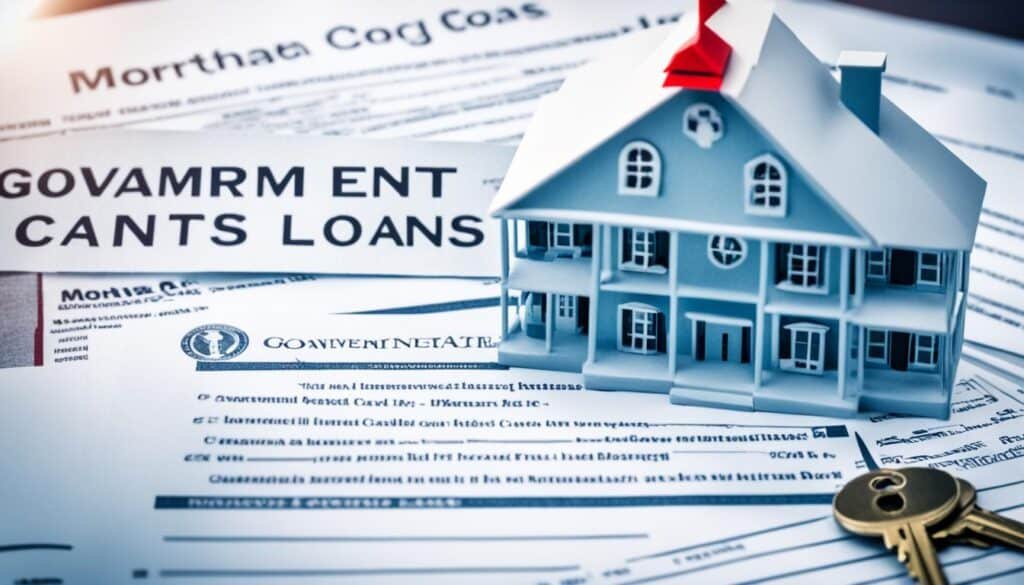
Looking to buy a home? Government-backed loans can make it easier. You can choose from FHA loans, VA loans, and USDA loans. Each has its own rules and benefits.
FHA Loans
FHA loans are insured by the Federal Housing Administration. They’re great for first-time buyers or those with lower credit scores. You don’t need as high a credit score as with other loans. But, you’ll pay upfront and monthly insurance premiums, which increases the loan cost.
VA Loans
VA loans are for military members, veterans, and their spouses. They offer 100% financing, so you can buy a home without a down payment. There’s a funding fee, but you can add it to the loan. This makes it easier for eligible borrowers.
USDA Loans
USDA loans help low-income buyers in rural areas. They need little to no down payment. These loans are for those with limited funds, as long as the home is in an eligible area.
When looking at mortgage options, think about each loan’s special features and rules. This will help you pick the best one for your money and home goals.
Fixed-Rate vs Adjustable-Rate Mortgages

Choosing a mortgage is a big decision. Homebuyers have two main options: fixed-rate and adjustable-rate mortgages. Knowing the differences between them helps buyers pick the right loan for their financial goals and future plans.
A fixed-rate mortgage has the same interest rate for the loan’s life, usually 10 to 30 years. This means your interest rate and monthly payment stay the same, no matter the market. Choosing a shorter loan term means higher monthly payments but less interest costs and quicker equity in your home.
An adjustable-rate mortgage (ARM) has an interest rate that changes with the market interest rates. ARMs start with a fixed rate for 3, 5, 7, or 10 years, then can change. This might be good if you’re planning to sell or refinance before the fixed period ends, offering lower initial payments. But, be aware that rates can go up later, making budgeting harder.
“The decision between a fixed-rate or adjustable-rate mortgage ultimately comes down to your financial situation and future plans for the home.”
When choosing between fixed-rate and adjustable-rate mortgages, think about your monthly budget, loan term preferences, and how long you plan to stay in the home. Talking to a mortgage expert can help you understand each option better. This way, you can pick a loan that fits your financial situation and goals.
First-Time Homebuyer mortgage loan Programs

As a first-time homebuyer, the mortgage world can seem overwhelming. But, there are many programs to help first-time homebuyers buy their dream home. These programs offer down payment assistance and closing cost assistance.
These programs are often run by state or local housing authorities. They give first-time homebuyers a boost by helping with down payments and closing costs. This can make buying a home easier.
The U.S. Department of Housing and Urban Development (HUD) lists first-time homebuyer programs by state. This makes it easier for first-time homebuyers to find what they need. FHA, VA, and USDA loans also have special programs for first-time homebuyers.
First-time homebuyers should look into these programs in their area. Using these resources can make buying a home less expensive. It can help make owning a home a reality.
| Program | Description | Eligibility |
|---|---|---|
| FHA Loans for First-Time Homebuyers | Offers low down payments and flexible credit requirements for first-time homebuyers. | Must meet FHA guidelines, including income and credit requirements. |
| VA Loans for First-Time Homebuyers | Provides first-time homebuyers who are eligible service members or veterans with 0% down payment options. | Applicants must be eligible active-duty military, veterans, or their spouses. |
| USDA Loans for First-Time Homebuyers | Designed to assist first-time homebuyers in rural and suburban areas with low-to-moderate incomes. | Must meet USDA income and property location requirements. |
Determining Your Budget
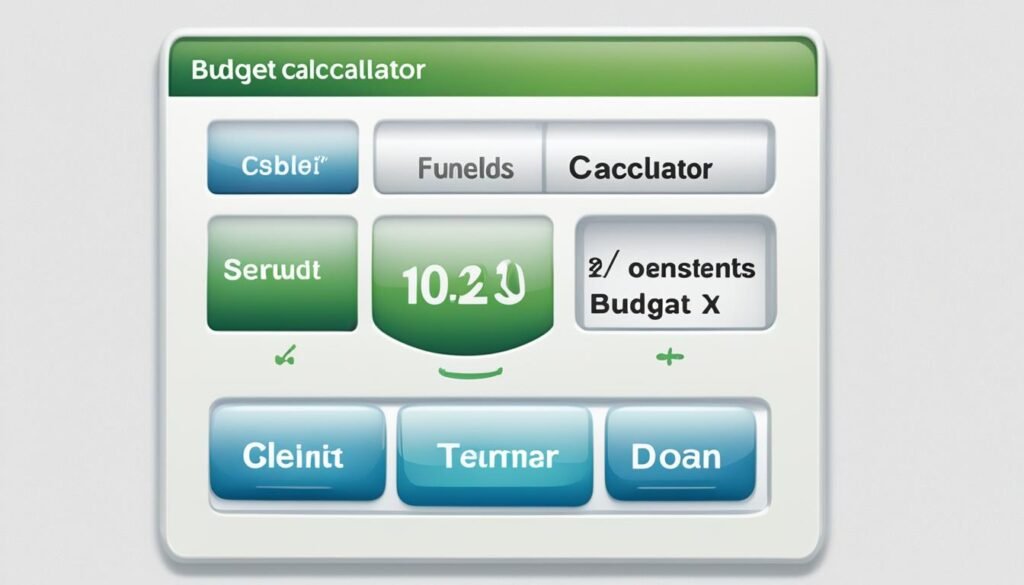
When buying a home, figuring out your budget is key. Lenders look at your income, loans, and debt. But they might miss other costs like utilities, childcare, and insurance. This means the loan offer might be more than you can really afford, leaving little room for surprises.
The 28/36 Rule
To keep your finances in check, follow the 28/36 rule. It says your housing costs should be no more than 28% of your income. And your total debt, including your mortgage, shouldn’t be over 36% of your income. This rule helps you avoid spending too much and keeps your finances stable.
An affordability calculator can help you figure out what home price and monthly payment you can handle. It looks at your income, housing costs, and debt ratio to give you a clear picture of what you can afford.
“Determining your budget is a crucial step in the home-buying process. By following the 28/36 rule and using an affordability calculator, you can ensure that your mortgage and other financial obligations fit comfortably within your means.”
Don’t just go by your lender’s preapproval amount. It might not be the real limit of what you can afford. By looking closely at your finances and sticking to the 28/36 rule, you can pick a home that suits your life and financial plans.
Comparing Lenders and mortgage loan Rates

Looking for the best mortgage loan means shopping around. It’s key to compare interest rates, annual percentage rates (APRs), loan terms, and fees from various mortgage lenders. This includes banks, credit unions, and online lenders. Exploring your options can save you a lot of money over time.
Begin by getting loan estimates from at least three lenders. Don’t just look at the interest rate. Check the APR, which includes interest and fees. This gives you a clear picture of the loan’s true cost.
Also, compare the loan terms and interest rates. Look at the down payment requirements, mortgage points, mortgage insurance, and closing costs. These can greatly affect how affordable the loan is.
Getting a preapproval from several lenders helps you see what you can borrow. It doesn’t guarantee you’ll get the loan, but it’s useful as you look for a home.
By comparing mortgage lenders and their rates and fees, you can make a smart choice. You’ll get the best terms for your money situation.
“The key to finding the best mortgage deal is to shop around and compare offers from multiple lenders. Don’t just focus on the interest rate, but consider the overall cost of the loan.”
Getting Pre-Approved for a mortgage loan

Getting a mortgage preapproval is key in buying a home. It shows your credit score, income, assets, and employment details. This lets lenders see how much you can borrow. By getting preapproved with different lenders, you understand your borrowing power and what to expect in your home search.
The process checks your financial documents like pay stubs and tax returns. Lenders also look at your bank statements and your current debts. They do a credit check to see if you’re good for a loan. This detailed check makes sure you’re pre-qualified, but the final approval depends on the property you choose.
Having a mortgage preapproval is a big plus in the housing market. It shows sellers you’re a serious buyer ready to act fast. It also lets you compare loans and rates from various lenders. This way, you can find the best deal on your mortgage loan.
“A mortgage preapproval is the first step in the homebuying journey, providing you with the confidence and clarity to make informed decisions.”
Getting preapproved helps you find the right mortgage loan for your budget. You’ll know your financial situation well. This lets you search for homes confidently and negotiate better, helping you reach your dream of owning a home.
Understanding Loan Estimates
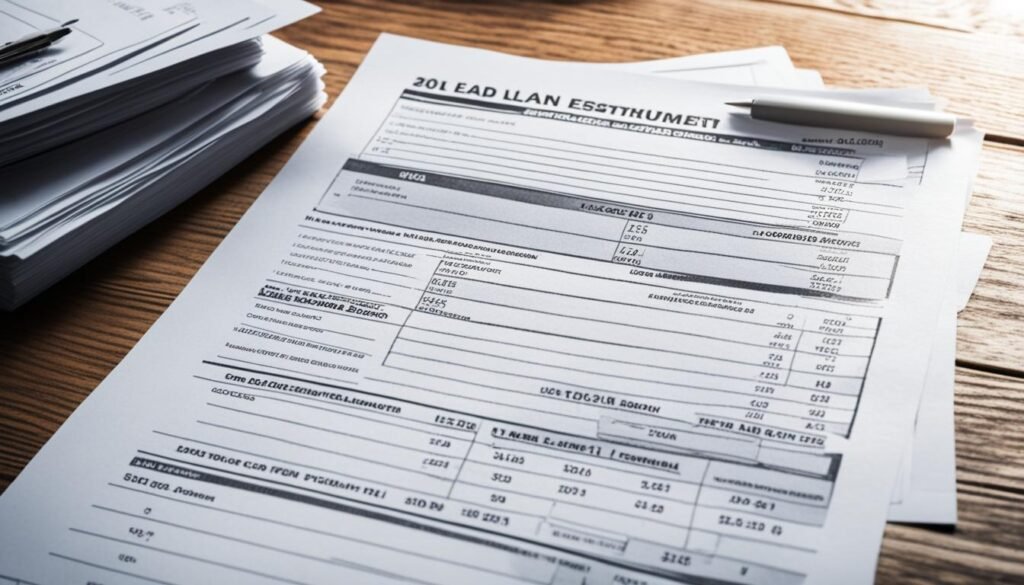
Lenders must give you a loan estimate within three days when you apply for a mortgage. This document lists the loan’s main details, like the interest rate, repayment term, fees, and third-party costs or lender credits. It’s important to check this info to avoid surprises that could affect your budget or cause buyer’s remorse.
The loan estimate shows which costs can be negotiated, like fees for title insurance, title search, appraisal, recording, and transfer taxes. Some lenders might offer lender credits to reduce the cash needed at closing. But remember, these credits can change the interest rate on your loan.
Before agreeing to the loan, make sure to read the mortgage agreement carefully. It’s as important as any other legal document. Understanding all the terms can help you make a smart choice and dodge any bad surprises later.
“The loan estimate should be studied as carefully as you would any other legally binding document. Missing important details could lead to unwanted consequences.”
Knowing about the loan estimate and your mortgage’s parts helps you make a better choice. It ensures your loan fits your financial plans and budget.
Types of Mortgage Lenders
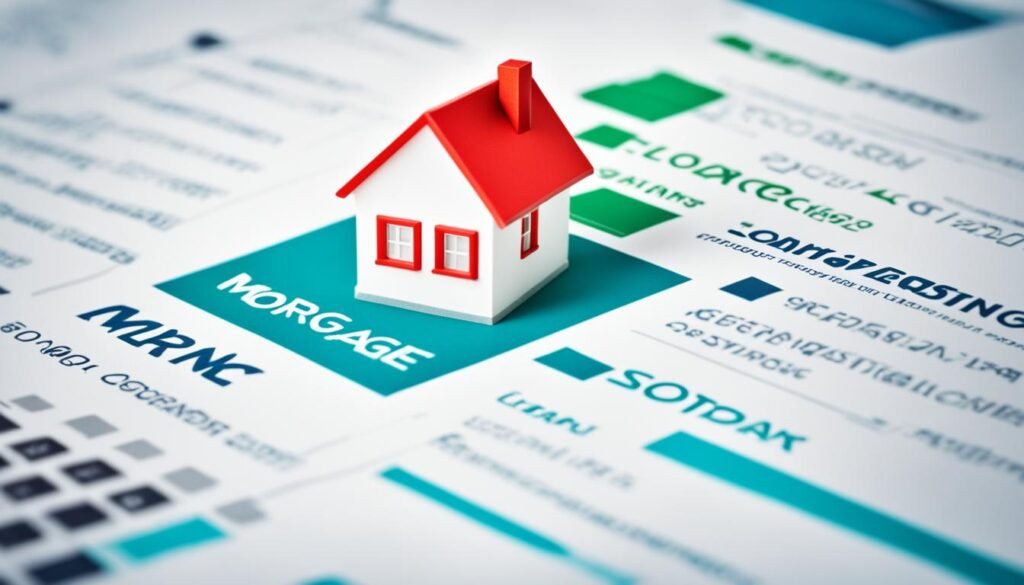
When looking for a mortgage, knowing the different types of lenders can help you find the right one. There are two main types: direct lenders and wholesale lenders.
Direct Lenders
Direct lenders include banks, credit unions, and other institutions that lend money directly to borrowers. They fund and service the mortgages themselves or use a third party for servicing. These lenders often have good rates and fees. You’ll work with the same loan officer from start to finish.
But, you need to shop around to get the best deal.
Wholesale Lenders
Wholesale lenders don’t work with borrowers directly. They partner with mortgage brokers and other lending institutions to offer mortgages. These lenders might be a good choice if you have less-than-perfect credit. They offer a simpler approval process and personalized service.
By comparing different wholesale lenders, you can find good rates and terms.
| Direct Lenders | Wholesale Lenders |
|---|---|
|
|
“Choosing the right mortgage lender can make a significant difference in your home-buying experience and long-term financial well-being.”
Also Read : How to Choose the Right Mortgage Broker: Insider Tips
Conclusion
Finding the right mortgage loan can seem tough, but with the right info and help, you can make your dream of owning a home come true. It’s important to know about the different mortgage types and how to compare loan rates and terms from various lenders. Each step in buying a home is key.
Getting pre-approved and checking loan estimates helps make sure the mortgage fits your financial plans and budget. Working with a reliable lender who understands your needs and offers tailored financing advice is crucial.
With the right mortgage, you’re on your way to a fulfilling homeownership journey. So, start this exciting adventure and let your dream of owning a home become a reality.
FAQs
Q: What is a mortgage loan?
A: A mortgage is a loan used to purchase a home or property. It is typically paid back over a specified term of the loan with interest rates.
Q: How do I choose the right mortgage loan for me?
A: To choose the right mortgage loan, consider factors such as your financial situation, the type of loan, interest rates, and the term of the loan that best fits your needs.
Q: What are the common types of home loans available?
A: Common types of home loans include fixed-rate loans, adjustable-rate loans, FHA loans, VA loans, and USDA loans.
Q: How can a mortgage calculator help me in the loan process?
A: A mortgage calculator can help you estimate your monthly payment amount, see how different loan options affect your payment, and determine the total cost of the loan over its life.
Q: What is the mortgage process like when getting a home loan?
A: The mortgage process involves application, loan approval, home appraisal, final loan approval, and closing. It may also include steps like obtaining mortgage insurance and property tax payments.
Q: What factors affect mortgage rates?
A: Mortgage rates can vary depending on your credit score, down payment amount, type of loan, term of the loan, and the current state of the mortgage market.
Q: Should I consider refinancing my mortgage?
A: Refinancing your mortgage may be beneficial if interest rates have dropped since you obtained your loan, if you want to change the term of your loan, or if you want to tap into your home’s equity.
Source Links
- https://www.investopedia.com/mortgage/mortgage-guide/how-to-choose-best-mortgage/
- https://www.bankrate.com/mortgages/finding-the-best-mortgage-lender/
- https://www.nerdwallet.com/article/mortgages/how-to-choose-the-best-mortgage






